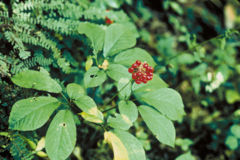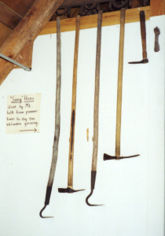Panax quinquefolius
| American Ginseng G3 Fossil range: {{{fossil_range}}}
| ||||||||||||||||||||||||||||||||||||||||||||||||||||||||||||||||||
|---|---|---|---|---|---|---|---|---|---|---|---|---|---|---|---|---|---|---|---|---|---|---|---|---|---|---|---|---|---|---|---|---|---|---|---|---|---|---|---|---|---|---|---|---|---|---|---|---|---|---|---|---|---|---|---|---|---|---|---|---|---|---|---|---|---|---|
 Panax quinquefolius foliage and fruit | ||||||||||||||||||||||||||||||||||||||||||||||||||||||||||||||||||
| Plant Info | ||||||||||||||||||||||||||||||||||||||||||||||||||||||||||||||||||
| ||||||||||||||||||||||||||||||||||||||||||||||||||||||||||||||||||
| Scientific classification | ||||||||||||||||||||||||||||||||||||||||||||||||||||||||||||||||||
| ||||||||||||||||||||||||||||||||||||||||||||||||||||||||||||||||||
| [[{{{diversity_link}}}|Diversity]] | ||||||||||||||||||||||||||||||||||||||||||||||||||||||||||||||||||
| {{{diversity}}} | ||||||||||||||||||||||||||||||||||||||||||||||||||||||||||||||||||
| Binomial name | ||||||||||||||||||||||||||||||||||||||||||||||||||||||||||||||||||
| Panax quinquefolius L. | ||||||||||||||||||||||||||||||||||||||||||||||||||||||||||||||||||
| Trinomial name | ||||||||||||||||||||||||||||||||||||||||||||||||||||||||||||||||||
| {{{trinomial}}} | ||||||||||||||||||||||||||||||||||||||||||||||||||||||||||||||||||
| Type Species | ||||||||||||||||||||||||||||||||||||||||||||||||||||||||||||||||||
| {{{type_species}}} | ||||||||||||||||||||||||||||||||||||||||||||||||||||||||||||||||||
| {{{subdivision_ranks}}} | ||||||||||||||||||||||||||||||||||||||||||||||||||||||||||||||||||
| [[Image:{{{range_map}}}|{{{range_map_width}}}|]] | ||||||||||||||||||||||||||||||||||||||||||||||||||||||||||||||||||
| Synonyms | ||||||||||||||||||||||||||||||||||||||||||||||||||||||||||||||||||
| {{{synonyms}}} |
Panax quinquefolius, commonly known as American Ginseng and often by its Chinese name Xiyangshen (Template:Zh-stp), is an herbaceous perennial in the ivy family that is commonly used in medicine. It is native to eastern North America, though it also cultivated beyond its range in places such as China.[1]
The plant's forked root and leaves were traditionally used for medicinal purposes by Native Americans. Since the 1800s, the roots have been collected by "'sang hunters," and sold to Chinese or Hong Kong traders, who often pay very high prices for particularly old wild roots.[1]

American Ginseng was formerly particularly widespread in the Appalachian region (and adjacent forested regions such as Pennsylvania and New York State), but due its popularity the wild plant has been overharvested, and is thus rare in most parts of the United States.[2] It is also grown commercially, under artificial shade, in fields in Wisconsin and Minnesota, and usually harvested after three to four years when ripe.[3]
Chemical components
Like Panax ginseng, American ginseng contains dammarane type ginsenosides as the major biologically active constituents. Dammarane type ginsenosides includes 2 classifications: the 20(S)-protopanaxadiol [ppd] and 20(S)-protopanaxatriol [ppt] classifications. American ginseng contains high levels of Rb1, Rd (ppd classification) and Re (ppt classification) ginsenosides -- higher than that of P. ginseng in one study. [2]
Pharmacokinetics
When taken orally, ppd-type ginsenosides are mostly metabolized by intestinal bacteria (anaerobes) to ppd monoglucoside, 20-O-beta-D-glucopyranosyl-20(S)-protopanaxadiol (M1). [3] In humans, M1 is detected in plasma from 7 hours after the intake of ppd-type ginsenosides and in urine from 12 hours after the intake. These findings indicate that M1 is the final metabolite of ppd-type ginsenosides. [4]
M1 is referred to in some articles as IH-901 [5] , and in others as compound-K. [4]
References
External links
- "There is More to a Forest than Trees" by Lynn Davis, College of Natural Resources, Virginia Tech
- "Roots and Regulations: The Unfolding Story of Pennsylvania Ginseng", by Melissa Beattie-Moss
- ↑ Template:Citation
- ↑ Shu Zhu et al (2004). "Comparative study on triterpene saponins of ginseng drugs". Planta medica 70 (7): 666–677. PMID 15303259.
- ↑ Hasegawa H et al (1996). "Main ginseng saponin metabolites formed by intestinal bacteria". Planta medica 62 (5): 453–457. PMID 8923812.
- ↑ 4.0 4.1 Tawab MA et al (2003). "Degradation of ginsenosides in humans after oral administration". Drug metabolism and disposition 31 (8): 1065–1071. PMID 12867496.
- ↑ Oh SH et al (2004). "A ginseng saponin metabolite-induced apoptosis in HepG2 cells involves a mitochondria-mediated pathway and its downstream caspase-8 activation and Bid cleavage". Toxicology and Applied Pharmacology 194 (3): 221–229. PMID 14761678.